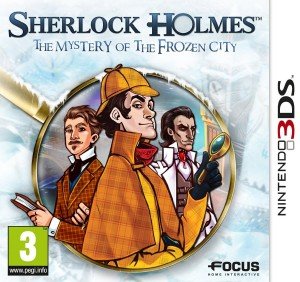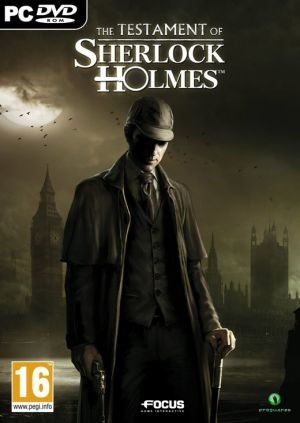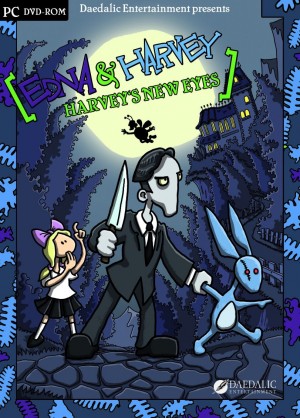Review for Sherlock Holmes and the Mystery of the Frozen City

London is in the grip of a mysterious ice storm. Springing out of nowhere, the unnatural weather has brought the city to a halt, even beginning to freeze the Thames. In their rooms at 221B Baker Street, Holmes and Watson are brooding on this strange phenomenon when a letter urgently calling for their assistance arrives. An experimental weather machine has been sabotaged, its vital control crystals needed to end the storm now missing. In Sherlock Holmes and the Mystery of the Frozen City for Nintendo 3DS, the two sleuths must search the exhibition for the missing crystals, along with clues to reveal the saboteur. Sadly, whilst facing an interesting variety of challenges in this casual puzzler, their investigation is hampered by some poor design decisions and a somewhat ludicrous plot.
The action takes place entirely within a scientific exhibition, with different areas dedicated to different types of inventions, such as a hall full of flying machines. The weather machine is a result of collaboration between several scientists, each of whom holds a set of the crystals needed to shut the machine down. The game is therefore effectively split up into chapters, as you try to gather each scientist’s set of crystals, whilst also pursuing information leading to the culprit. The freezing of the city is only the start of the plan, however, as an army of robots moves in to take over, converging on the exhibition as your efforts start to reverse the effects of the storm.
This is not a story that bears close scrutiny, and the convoluted process to close down the machine feels like a wholly artificial contrivance. A safety mechanism that requires a disparate group of individuals to be in the building at the same time does not strike me as particularly safe, and there is no reason why the saboteur could not destroy this system as well. The panel in the side of the machine where the crystals are inserted is easily accessible, and it would be child’s play to damage it. For that matter, as I placed crystals in the machine whenever I found them, the saboteur could simply have removed them and thrown them away. The extreme cold is required for the invading robots to operate, as a lack of cooling mechanism causes them to explode in all but the lowest temperatures. Creating a vast storm rather than adding such a mechanism seems like an overly complex plan to me, and since it is later revealed that the robots cannot operate in heated buildings anyway, the invasion would appear to be a non-starter, even with the storm in place.
The story doesn’t fit well with the Sherlock Holmes canon either. The original tales were always based firmly in reality, with any fantastical elements given a down-to-earth explanation by the end. By contrast, this tale is packed with fantastical elements, including a teleportation machine and a pair of glasses with filters that x-ray items and allow you to see into the past. Holmes himself comes across as less brilliant than usual. The scientific exhibition appears to be well-publicised, but Holmes has to be called to it to discover it is the source of the storm. He relies heavily on the aforementioned glasses in places where you would expect his keen detective instincts to direct his actions. When he does pronounce his deductions, they seem based on obvious details such as noting that a scene of an unmasked saboteur must have happened after said saboteur had their mask ripped off. With other oddities like Inspector Byrne of the Yard replacing Inspector Lestrade, it feels like a familiar headline name was chosen by the developers with only cursory knowledge of the source material.
The background graphics are hand-drawn and include a nice amount of detail. Offices have untidy desks and packed bookshelves, and the exhibition halls are full of intriguing machines, many of which crackle with electricity or give off bursts of steam. With bright colours, crisp lines and good use of shading, the various locations really come to life. The characters are equally well-painted, with some of their own idle animations and expressive faces. During conversations, half-body stills of the people speaking appear behind their dialogue. These change depending on the situation, such as covering them with snow during conversations taking place on the roof. Several locations are wider than the screen, and panning slightly rotates the view of larger items as if the player was moving sideways across the room.
Had this been a DS title, The Frozen City's graphics would have been highly effective. Unfortunately, on the 3DS they do not fare so well. In stereoscopic 3D, too many items appear to be made up of thin sheets, creating the effect of a child’s cardboard theatre production. Even the changing views of the larger items still feel like cutouts rather than solid objects. The characters come out worst of all, looking like paper dolls animated by pins holding them together at the joints. Whilst it seemed a waste of the console’s ability, I found turning the 3D off made this game much easier on the eye.
Music consists of a handful of tunes that loop continuously. These range from a jaunty dramatic piece at the start to a gentle melody of largely woodwind. The move from one style to another blends fairly well, with no jarring shifts to break immersion. Whilst the soundtrack is pleasant enough to listen to, however, I didn’t find it particularly inspiring. There are also simple sound effects throughout, such as the hissing of machinery and the squeaking of screws. The game is completely unvoiced, even in the numerous cutscenes.
The upper screen is used for the main display, and control is almost entirely handled with the stylus. Sliding the stylus on the lower screen moves a cursor on the upper screen, somewhat like using a touchpad. When the cursor is over an interactive area it changes shape to signify pick up or interact options, and lifting the stylus takes the appropriate action. Moving the cursor to the edge of the screen pans across a wider area where applicable. Panning can also be achieved using the control pad, which initially feels odd but soon becomes natural. You'll need the stylus in any case, as the touch screen also has functions like the inventory as buttons in each of the four corners. In exploring the corners of the upper screen you can inadvertently activate these buttons on the lower one, though a faint copy of the button appears to warn you when this is a risk. During the many minigame puzzles you encounter, which often require finer manipulation, the action shifts strictly to the bottom screen, with the top screen simply displaying a title screen for the current challenge.
Travel around the exhibition is done by means of a map which allows you to hop instantly from room to room. This map also includes symbols showing which rooms have unfinished activities in them, as well as blocked doors. The map is only labelled with simple illustrations of its contents, but it proves relatively easy to navigate using the symbols as guides. Within each room you will search for items to interact with and collect. Much of the machinery is inoperative for various reasons, requiring you to gather parts such as cogs or pipes necessary to get them working again. This results in recurring scavenger hunting gameplay, as you scour the various available rooms for the missing items. When you have at least one item of a set in your possession, the inventory shows how many are required in total to complete that particular challenge. To aid the less eagle-eyed, the A and B buttons allow zooming in and out. There is also an on-screen help button which will shift the view and briefly sparkle around interactive items.
Some objects, such as a camera or robot, contain items you need within them or as part of their structure. When you find one of these, you are presented with a standalone 3D representation of the object on the touch screen, which can be rotated freely in all directions. Using the stylus you can select specific parts in order to remove them to get at what you need. Dismantlement puzzles could have provided an opportunity for some intriguingly complex challenges as you try to manoeuvre pieces out of the way. Sadly, simply clicking on a part instantly removes it when possible, and since the order is not always logical, these become simple exercises in trial and error instead.
As well as hunting for multiple item sets, you also need to find a suitable substitute for a missing oar and make use of various tools. These can be selected from the inventory and mini-versions attach to the on-screen cursor to show they are ready for use. The sci-fi glasses also make repeated appearances throughout the game. When you initially acquire them, they are completely inoperative, requiring various lenses to be useful. These are collected over the course of the game, starting with an x-ray lens and increasing in options as time passes. Selecting one of these lenses and using the glasses on certain areas reveals clues vital to progress. Strangely, the dialogue puzzles implied by the “interrogate many characters” promise on the box fail to materialise. Instead, conversations are simple one-track affairs, in which Holmes largely appears ready to take people at their word rather than as suspects in a crime.
More than 50 minigames appear throughout the game, including cracking lock combinations, placing cogs, and rearranging a pipe network. These challenges are mostly untimed, though there are a couple where you're required to be moderately quick. Instructions are shown immediately prior to starting the activity, but aren't visible on-screen whilst doing the puzzle. They are available at the tap of a button if required, but this is an odd choice, as the top screen could easily have accommodated instructions by default.
There are some intriguing puzzles on offer here. A challenge to arrange a circle of lights so that sixteen particular combinations appear around its circumference proved harder than it looked. Another game where you challenge one of the scientists to help him focus his mind also proved simple in design but tricky to solve. There are also some classics available, such as a solitaire-based game and a pair of sliding box puzzles. Unfortunately, some clunkers have entered the mix as well. Avoiding touching the sides of a maze is made unnecessarily difficult by the screen blacking out as soon as you start moving. There is also a dice-based game that appears to solely rely on luck to win.
The difficulty is not helped by unclear instructions on a number of puzzles. One task involving arranging squares in a pattern states, “One square cannot be moved alone”. I took this to mean that squares had to be moved in groups of at least two. In fact, this simply means you cannot move a square so it no longer touches any other square, a distinction that makes a great difference to solving the puzzle. The puzzles themselves are generally easier than those in the Professor Layton games, making The Frozen City more accessible for the casual player. For those who find a particular minigame too difficult, there is a skip button available. However, you must wait for it to charge up before becoming active, which can take approximately seven minutes, so this is unlikely to see much use. I did not find any optional puzzles beyond those required for your quest, but the game does include an index for replaying discovered challenges.
The main problem with the puzzles is that they do not make sense in the context of the setting. A complex bead puzzle seals the box that contains the keys to the kitchen. Fitting rivets to a boiler involves tapping them in different combinations until all stay down at once. The puzzle where the maze blacks out takes place in broad daylight. Doors to mundane areas of the building, such as the guest lounge, are locked with puzzles rather than keys. A freshly developed photo comes out inexplicably mixed up. Whilst some of the missing objects have been deliberately concealed, making their scattering logical, many are arbitrarily split. This is taken to new heights when four specific items are needed to make a barricade when there are plentiful other items around the building that are suitable for the job. Even the inventory puzzles don’t all make sense. One requires you to open a box to acquire an empty bottle, when several bottles you could easily empty sit close by. Whilst some level of contrivance is not unusual in adventure games, this is going too far.
I went into this game hoping to step into the shoes of the Great Detective, but this game fails to authentically offer that experience. The variety of gameplay managed to hold my interest throughout its 5-6 hour play time anyway, but the jarring lack of puzzle integration constantly broke any sense of narrative immersion, and I found the plot more an irritating distraction than a fascinating investigation. The 3D presentation does not serve the graphics well, and players may find reverting to 2D advisable this time around. As a fairly casual handheld puzzler, Sherlock Holmes and the Mystery of the Frozen City is more accessible than the Professor Layton games, so younger gamers or those looking for some lite entertainment on the go will find some enjoyment here, but hardcore adventurers and die-hard Holmes fans are likely to find this 3DS title too elementary.
WHERE CAN I DOWNLOAD Sherlock Holmes and the Mystery of the Frozen City
Sherlock Holmes and the Mystery of the Frozen City is available at:
We get a small commission from any game you buy through these links (except Steam).Our Verdict:
Feeling more like Layton-lite than heavy-duty Holmes, Mystery of the Frozen City is for those who enjoy casual puzzling enough to overlook a nonsensical story.
You don't want to miss these articles
Adventure Gamers Community
Community reviews for more Adventure Games (randomly selected)
Review of Gabriel Knight 3: Blood of the Sacred, Blood of the Damned
Rating by Arial Type (May 21, 2012)
Review of Gabriel Knight 3: Blood of the Sacred, Blood of the Damned
Rating by Arial Type (May 21, 2012)



_capsule_fog__medium.png)


























